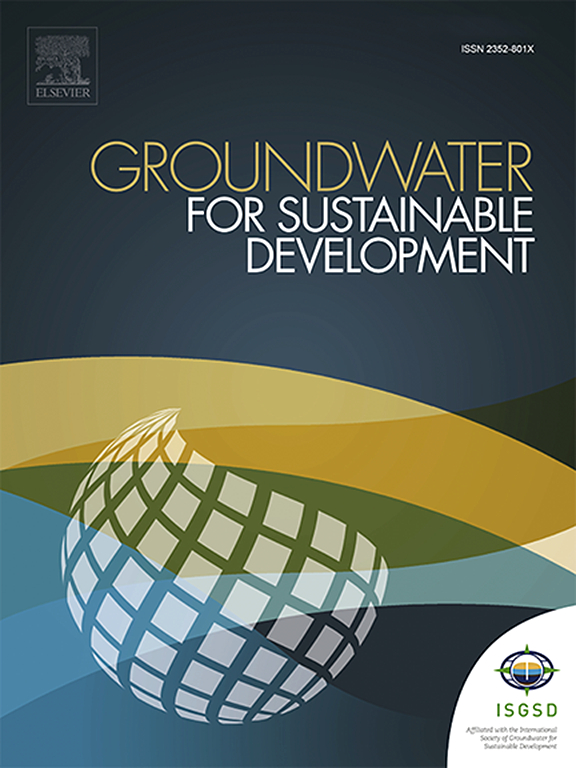Advances in the treatment of arsenic-contaminated groundwater by the adsorption onto iron-coated cork granulates on fixed-bed column
IF 4.9
Q2 ENGINEERING, ENVIRONMENTAL
引用次数: 0
Abstract
Iron-coated cork granulates (ICG) are an emerging adsorbent successfully tested in continuous mode to remove arsenic and other oxyanions from water. Novel adsorbents are reported in the literature to show good arsenic adsorption capacities in aqueous solution; however, many fail to reach WHO limits for drinking water when treating natural water with a complex matrix. The present study investigates the performance of ICG on arsenic adsorption using different groundwater (GW) matrices, from wells in Portugal (pH 6.95 ± 0.01, NO3− = 30 mg L−1, Cl− = 20.4 mg L−1, PO43− = 0.12 mg L−1) and The Netherlands (pH = 7.4 ± 0.1, NO3− < 0.27 mg L−1, Cl− = 1097 mg L−1, PO43− = 0.502 mg L−1). Groundwater (As-spiked or not) was treated in lab-scale fixed-bed columns from initial concentrations (11–300 μg L−1) to levels below the arsenic WHO guideline and European Union Directive 2020/2184 of 10 μg L−1. The effect of an oxidation-filtration pretreatment was also investigated.
The ICG presented good performance when using real groundwater as feed across a wide range of arsenic concentrations. In all cases, the WHO guidelines and the European Commission's limit for arsenic in drinking water could be reached. The ICG performed better in the GW matrix from The Netherlands than that from Portugal. That could be attributed to the elevated concentrations of nitrate in the Portuguese matrix, which might be more competitive with the arsenic oxyanions for the ferric sites in the adsorbent, compared to the more abundant chloride in the Dutch matrix. Moreover, the pretreatment using the aeration/sand filter reactor improved the arsenic removal in the Dutch matrix. It reached values of breakthrough time, treated volume at breakthrough and bed volumes at breakthrough of 39 ± 1 h, 11.7 ± 0.4 L, 202 ± 6, respectively, for an initial concentration of 0.30 ± 0.04 mg L−1. This study showed that the use of low-cost, environmentally friendly iron-coated cork granulates to remove arsenic from groundwater is feasible at different concentrations in different water matrices.

固定床柱上铁包覆软木颗粒吸附砷污染地下水的研究进展
铁包覆软木颗粒(ICG)是一种新兴的吸附剂,成功地在连续模式下去除水中的砷和其他氧离子。文献报道了新型吸附剂在水溶液中具有良好的砷吸附能力;然而,许多国家在用复杂基质处理天然水时未能达到世卫组织的饮用水限量。本研究研究了不同地下水基质下ICG对砷的吸附性能,分别取自葡萄牙(pH = 6.95±0.01,NO3−= 30 mg L−1,Cl−= 20.4 mg L−1,PO43−= 0.12 mg L−1)和荷兰(pH = 7.4±0.1,NO3−<;0.27毫克L−1,Cl−L−1 = 1097毫克,PO43−L−1)= 0.502毫克。在实验室规模的固定床柱中处理地下水,从初始浓度(11-300 μg L−1)到低于世卫组织指南和欧盟指令2020/2184的10 μg L−1的砷水平。考察了氧化-过滤预处理的效果。当使用真实地下水作为饲料时,ICG在广泛的砷浓度范围内表现出良好的性能。在所有情况下,世界卫生组织的指导方针和欧盟委员会对饮用水中砷的限制都可能达到。ICG在荷兰GW基质中的性能优于葡萄牙GW基质。这可能是由于葡萄牙基质中硝酸盐的浓度升高,与荷兰基质中更丰富的氯化物相比,葡萄牙基质中硝酸盐的浓度可能更能与砷氧离子竞争吸附剂中的铁离子位置。此外,曝气/砂滤反应器预处理提高了荷兰基质中砷的去除率。初始浓度为0.30±0.04 mg L−1时,突破时间为39±1 h,突破处理体积为11.7±0.4 L,突破床层体积为202±6 L。本研究表明,在不同的水基质中,使用低成本、环保的铁包覆软木颗粒去除地下水中不同浓度的砷是可行的。
本文章由计算机程序翻译,如有差异,请以英文原文为准。
求助全文
约1分钟内获得全文
求助全文
来源期刊

Groundwater for Sustainable Development
Social Sciences-Geography, Planning and Development
CiteScore
11.50
自引率
10.20%
发文量
152
期刊介绍:
Groundwater for Sustainable Development is directed to different stakeholders and professionals, including government and non-governmental organizations, international funding agencies, universities, public water institutions, public health and other public/private sector professionals, and other relevant institutions. It is aimed at professionals, academics and students in the fields of disciplines such as: groundwater and its connection to surface hydrology and environment, soil sciences, engineering, ecology, microbiology, atmospheric sciences, analytical chemistry, hydro-engineering, water technology, environmental ethics, economics, public health, policy, as well as social sciences, legal disciplines, or any other area connected with water issues. The objectives of this journal are to facilitate: • The improvement of effective and sustainable management of water resources across the globe. • The improvement of human access to groundwater resources in adequate quantity and good quality. • The meeting of the increasing demand for drinking and irrigation water needed for food security to contribute to a social and economically sound human development. • The creation of a global inter- and multidisciplinary platform and forum to improve our understanding of groundwater resources and to advocate their effective and sustainable management and protection against contamination. • Interdisciplinary information exchange and to stimulate scientific research in the fields of groundwater related sciences and social and health sciences required to achieve the United Nations Millennium Development Goals for sustainable development.
 求助内容:
求助内容: 应助结果提醒方式:
应助结果提醒方式:


